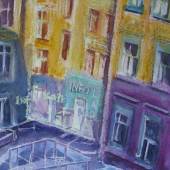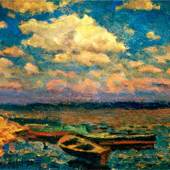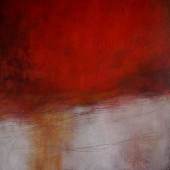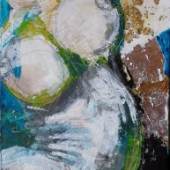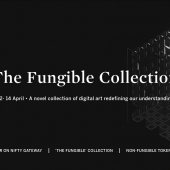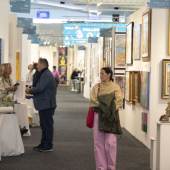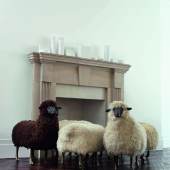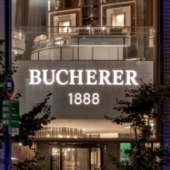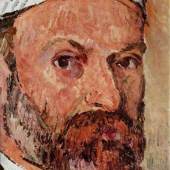Ed Ruscha’s Standard Station, Ten-Cent Western Being Torn in Half
-
Auktion19.11.2024
‘You want the thing to glimmer. You want it to have inner power,’ Ed Ruscha once said. The writer Mark Rozzo takes a closer look at one of the most important images of American art
One of the original US highways, the historic Route 66, which stretches from Chicago to Los Angeles, is an icon of American culture lending its backdrop to popular movies, television shows, literature, music and art.
Over several decades, Los Angeles-based artist Ed Ruscha would regularly traverse the famed roadway to visit his family in Oklahoma City. Armed with his camera and a penchant for the banal, Ruscha documented the roadside gas stations that dotted his journey — eventually converting one of his modest black-and-white photographs into a dramatic sequence of paintings.
Ruscha’s paintings of the Standard station defined the modern American landscape and contributed to the bold visual language of the 1960s.
On 19 November 2024, Christie’s New York is honoured to offer Standard Station, Ten-Cent Western Being Torn in Half (1964) as part of the 20th Century Evening Sale.
‘Standard Station, Ten-Cent Western Being Torn in Half is the great synthesis and climax of his masterpieces of the early 1960s,’ explains Christie’s Vice Chairman, Max Carter. ‘Monumental and rich in paradox, it is an icon of the post-war era, of the west, of American art.’
Mark Rozzo, the author of Everybody Thought We Were Crazy: Dennis Hopper, Brooke Hayward and 1960s Los Angeles, traces the origins of this 20th century tour-de-force in the accompanying catalogue essay, High Octane. Below, we share an exclusive excerpt from the text.
Excerpts from ‘High Octane’ by Mark Rozzo
In August of 1956, the 18-year-old Ed Ruscha set out for Los Angeles from his hometown of Oklahoma City in a 1950 Ford. His copilot was his high-school best friend, a precocious teenage musician named Mason Williams.
Their 1,300-mile odyssey is a standard component of the Ruscha origin story, not to mention the cosmology of postwar American art: You could argue that what Warhol was to Campbell’s soup cans and Brillo boxes, Ruscha has been to highways — the all-American, high-speed built landscape of yammering signage and cheapo architecture. Roads, streets, freeways, the blown-tire detritus on their shoulders, the endless sequence of gas stations that line them: Ruscha has been a visual bard of the world as seen through a windshield.
As Adam D. Weinberg, the former director of the Whitney Museum, once put it, ‘No American artist has a more singular vision of the American landscape, especially the impassive iconography of the road, than Ruscha.’ Or, as Ruscha himself said, ‘Everything you see on the street I’m influenced by.’
After arriving in Los Angeles, Williams would eventually find work as a writer for the Smothers Brothers Comedy Hour and fame as the AM-radio hitmaker behind ‘Classical Gas’. (Ruscha created the artwork for Williams’s 1969 LP, Music.) For his part, Ruscha — a kid with a fixation on India ink who had once dreamed of becoming a comic-book artist — found a car-centric city that had, in his words, ‘the right kind of decadence and lack of charm to make an artist’. Make him an artist it did, even if Ruscha, in contrarian fashion, has occasionally deflected this notion. ‘Being in Los Angeles’, he said in 1966, ‘has had little or no effect on my work.’ Nevertheless, Ruscha grew to become L.A.’s artist laureate by near-universal acclamation. The city has remained his base of operations since the day he arrived 68 years ago.
****
ON ROUTE 66: OKLAHOMA TO LOS ANGELES
One way or another, about six years later, Ruscha was reversing the course, driving back home from Los Angeles along Route 66 to Oklahoma City to visit his family. This time he’d brought a camera. It’s easy to imagine how it might have unfolded: The gas station in northeast Amarillo caught his eye. It was on the left now. Ruscha stopped, photographed it from across the road, may or may not have gassed up, kept driving. He’d been doing this for much of the route, stockpiling images of service stations — the less interesting, the better.
He would spin this aggressively boring visual documentation of aggressively boring architectural phenomena into an artist’s book with an aggressively boring name: Twentysix Gasoline Stations, published in 1963, available for mail order at three dollars a pop. Ruscha sent a courtesy copy to the Library of Congress, which returned it to the artist with a polite but curt letter, ostensibly rejecting the volume for its lack of informational or aesthetic value. Ruscha would then transform one of the 26 black-and-white photographs from the book — the one of the Standard station on Northeast Eighth Avenue (now East Amarillo Boulevard), in Amarillo — into what is arguably his best-known image as a fine artist.
****
A TRADEMARK OF SORTS
Ruscha would later claim that he originally had no intention of ever using the photographs from Twentysix Gasoline Stations as the basis of painted works. But after the book came out, he began conceptualizing how to transfer the image of the Standard station in Amarillo into a large-scale painted image: ‘a gargantuan approach to a big canvas,’ as he later summed it up.
-
12.04.2021 - 14.04.2021By Pak • 12- 14 April • A novel collection of digital art redefining our understanding...
-
20.04.2022ARTEXPO NEW YORK CELEBRATES ITS 45TH ANNUAL EDITION WITH A RENAISSANCE IN CONTEMPORARY AND FINE...
-
23.05.2018NEW YORK, 16 May 2018 – Today, Sotheby’s is honored to unveil the full contents of A...
-
Gegen Ende seine Lebens malt und zeichnet Cézanne wiederholt das Motiv der "Badenden"....
-
19.11.2024Auktion »
Exhibition
18 March – 17 May, 10am – 6pm
Closed on Saturdays, Sundays, and Public HolidaysLocation
Unit L20C, 20th Floor, Gaysorn Tower
127 Ratchadamri Road, Lumpini, Patumwan, Bangkok
10330

